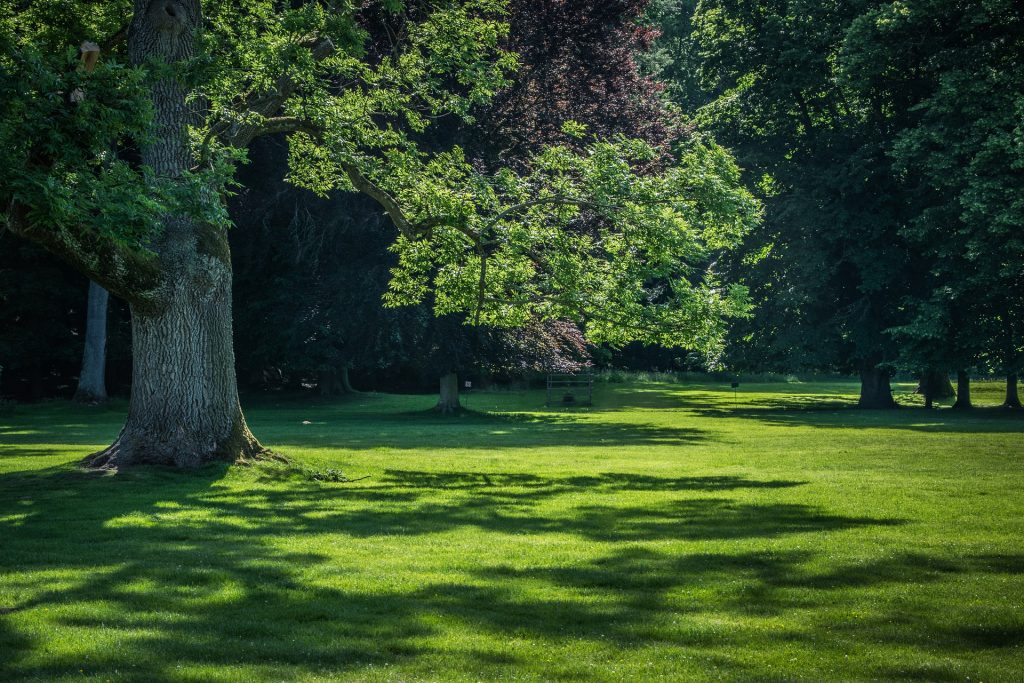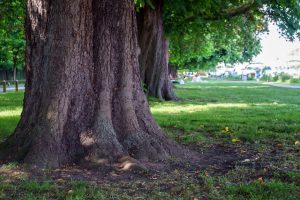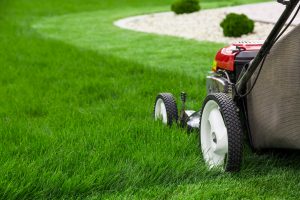
Shade on your lawn is a double-edged sword. In the Southeast, where summers are hot and humid, shade can be a welcome relief as you enjoy your outdoor spaces. Many flowers and other plant varieties require some bit of shade too. However, the same shade that keeps you and other plants comfortable in the heat of summer can be very destructive for your turf. Most turf requires full sunlight for at least 8 hours a day to thrive. Many lawns don’t have that much light. So what are the alternatives? Is there a type of turf that can tolerate shade better? What can I do to make sure my turf survives in the shade? We’ll try to help you determine the best turf for shade to help your lawn stay thick, even under the trees.
The Effect of Shade on Turf Grass
Let’s start by saying that there isn’t any turf that will thrive in deep shade. Deep shade is an area that never receives direct sunlight, such as an area between two homes where the shadows persist all day. However, areas of your lawn that receive dappled sunlight or get at least 4 hours of direct sunlight are candidates for more shade-resistant turf grasses. Certain types of turf grass are the best turf for shade and better suited for growing in the more shaded areas around your home.

Vital Ingredients to Grass Growing
Any grass needs sunlight, water, and nutrients to grow. When grass doesn’t get its full share of those vital ingredients, it will not grow as well as it could given the right conditions. In an area shaded by trees, lawn grass receives less light. The grass’s roots compete with the tree roots for vital nutrients. A large tree can spread out roots far beyond the area covered by the tree’s canopy. And most of those roots grow within six inches of the surface, close enough to compete for nutrients with grass. Without irrigation, grass that grows in the shade of a tree would also receive less water. All of these issues are why turf grass is the right switch for you!
Irrigated Gardens in the Shade
However, in an irrigated garden, the problem is actually the opposite. An irrigated garden has sprinklers or pipes that are watering the area. This type of gardening does not rely on rainwater as a vital piece of the puzzle. It is getting water supplied in more directed and consistent ways. The problem with shaded areas in an irrigated garden is that they don’t dry as quickly as parts of your lawn that receive full sun. So the main danger is overwatering, which raises the risk of weeds and fungus. These problems jeopardize the longevity of the garden and the potential growth it holds if it were to be taken care of in the right conditions.
Grass that grows in shade will grow thin and spindly as it stretches to reach sunlight. Remember when you are escaping the sunlight and you step into a shaded area under the tree? The grass is more sensitive to other stresses, such as foot traffic! Even in the best circumstances, turf grown in shaded areas will typically have weaker, shallower roots. Shaded grass also grows more slowly, as it receives fewer of the ingredients necessary to grow. But turf scientists have worked hard to develop unique cultivars and the best turf for shade that can grow strong and lush even in shaded areas!
Choosing a Shade-Tolerant Turf Grass
Most grass does best in direct sun. That means even shade-tolerant turf cultivars will be weaker in the shade. A cultivar is a plant variety that had been produced in cultivation by selective breeding. It is selected and cultivated by people, usually botanists to make it the best version and see where it can be the most successful. In general, cool-season grasses perform better in the shade. But here in the Southeast, where warm-season grasses are preferred, some still do better than others. Among warm-season grasses, Zeon Zoysia Grass is the best suited for partial shade. Partial shade means 50% sunlight all day, or 100% sunlight for at least four hours each day.
One example of commercial Zeon Zoysiagrass in the shade is Centennial Olympic Park in downtown Atlanta. Initially, the amphitheater was planted with bermudagrass, which grows well in the hot Atlanta summers. But when it became apparent that the amphitheater would need a cloth shade cover to minimize the hot sun beating down on pedestrians, they switched to Zeon Zoysiagrass. The groundskeepers were amazed by how well the turf grew in the partial shade of the cloth shade cover! The turf stayed intact, bright, and in good condition despite the consistent shade and foot traffic. Zeon Zoyiagrass is the best turf for shade, and it has been proven many times!
Adjustments for Growing Turf in the Shade
If you want to grow turf in the shaded areas of your lawn, you will have to make some adjustments to both your cultivation practices and the area around the turf. With the right management, you can grow healthy turf even in partial shade. Growing turf in the shade can be done! Below are some tips to make sure your shaded turf is grown to the best of your ability.
Choose the Right Turf
Growing turf in a shaded area starts with the right turf. Among warm-season varieties, Zeon Zoysiagrass stands out as an especially shade-tolerant cultivar; it is the best turf for shade. One of its defining characteristics is that it grows well in the shade and it is drought tolerant. It has extraordinary visual appeal with a deep green color, sure to please the eye! It stays green longer into the season and starts up earlier than most in the early spring season. With vigorous roots, it has the strength to compete for nutrients with shallow and strong tree roots. In fact, due to the extensive root system, the Zeon Zoysiagrass rebuilds quickly from an injury to the compact turf. In trials, it tested much higher in quality than other zoysia varieties.
Selectively Prune Tree Branches
Even Zeon Zoysiagrass needs 4 hours a day of direct sunlight or 8 hours of at least 50% sunlight. To allow for enough sunlight, you may need to prune some of the trees that are creating the shade. Prune branches below eight feet to allow for direct sunlight in the morning and evening, when the sun is low. For taller trees, prune branches in the lower third of the tree. Selectively pruning canopy branches to thin the canopy can also help create more partial sunlight in the middle of the day. When maintained properly, pruning trees is an easy task that brightens up the yard in more ways than one. It allows for more sunlight on the plants and grass, but also makes the yard look neat and kept nicely. Pruning is necessary maintenance to improve the lifespan of the tree!
Fertilization
It’s important to fertilize shaded areas just as it’s necessary to fertilize the rest of your lawn. However, turf in shaded areas grows more slowly and needs less fertilizer than sunny parts of your lawn. Save your money and supplies by using half as much fertilizer on shaded areas as on the rest of your lawn. This is another great benefit of turf, and it’s helpful to know that the best turf for shade does not require the same amount of supplies as full sun grass.
Soil Management
Also, a tree’s root system can have a significant effect on the soil around it. It is so important to check the pH of the soil in the area where you are trying to grow turf. It may be necessary to add lime or otherwise adjust the pH so the turf has the best opportunity to be successful!
Zeon Zoysiagrass will consistently establish itself in many different soil types. When tested, Zeon Zoyiagrass exhibited superior genetic characteristics. This is why it is the best turf for shade!

Increase Mowing Height
Shaded turf receives less sunlight, so you want to make the most of the sun that does reach the grass. The green blade of the grass absorbs sunlight for photosynthesis, effectively feeding the plant. The longer the blade of grass, the more surface area the plant has to absorb sunlight. This means the greener the grass and the better the eye appeal! It’s generally recommended to mow Zeon Zoysiagrass to about one and a half inches, but in shaded areas, you can increase that to two or even two and a half inches.
Turf in shaded areas grows more slowly than in full sunlight, so it may not be necessary to mow the shaded areas every time you mow the sunlit areas. What another great way to save time! Instead, keep track of the growth in the shaded area and maintain a separate schedule to keep it at the correct height. More tips about mowing your lawn can be found here, “How Often Should You Mow the Lawn?”
Irrigation
In general, shaded areas will stay moist longer and require less irrigation. You’ll save a lot of water with shaded areas. The best turf for shade requires less water because the sunlight is not hitting the grass and making the water evaporate as quickly!
Exceptions
However, in the heat of the summer, trees can soak up a lot of water and may out-compete the turf for water. Keep an eye on soil moisture to determine when you need less or more irrigation. You will likely have to adjust irrigation levels throughout the growing season. In any case, irrigation requirements in shaded areas will not be the same as in sunlit areas, so they should be monitored separately. In the long run, money will be saved because of the soil retaining the water uses less irrigation!
Leaf Removal
If you are attempting to grow turf in a shaded area, you want to give your turf as much access to sunlight as possible. There are ways to ensure the turf gets the most amount of sunlight. One way is to rake and remove fallen leaves as quickly as possible. Fallen leaves block sunlight, so getting them off your turf promptly is super important for the quality of the grass. While large amounts of fallen leaves only pile up during the fall, individual leaves may fall even during spring and summer. Check for fallen leaves or other debris throughout the growing season, and remove anything blocking out sunlight as soon as possible to promote growth in your turf.
Minimize Traffic
Even lush, healthy-looking turf in shaded areas is weaker than similar grass growing in full sunlight. Shaded turf will not recover as quickly from traffic, and it is more sensitive to compacted soil. It is so easy to congregate in the shaded areas of the yard on those hot summer days. The best turf for shade is when it has all the right ingredients to prosper and thrive. Try to minimize traffic in shaded areas to improve the health and longevity of the turf and the surrounding trees.
Weeds in Shaded Areas
While shade is not ideal for turf, it is perfect for many types of weeds. The moist soil and reduced competition from turf encourage weeds to flourish in this damp environment. Treat shaded turf with a preemergence herbicide in early spring to prevent weeds from sprouting up in the shade. It may also be necessary to treat shaded turf with postemergence herbicides later in the season to get any stubborn weeds out of the way. Some herbicides can damage trees and shrubs, so be sure to read any warnings on your herbicide before applying it. You only want to spray the herbicide to get rid of weeds while also preserving your other plants. If the weeds are not too prevalent, it may be preferable and easier to remove them by hand. Whether you do this by hand or will herbicide sprays, you are working towards getting the harmful plants away from the turf. This way the weeds are not stealing vital nutrients from your precious grass!
Disease in Shaded Turf
Decreased airflow, increased moisture, and weaker turf are the perfect conditions for turf disease and fungus. Homeowners should monitor shaded turf closely for signs of disease and apply fungicide at the first signs of fungal disease. Also, it is important not to overwater in shaded areas, since increased moisture and slower drying times can exacerbate disease conditions. It is all about monitoring the turf to see how it is adjusting to the weather changes, shaded conditions, and watering amounts.
Zeon Zoysiagrass Is the Best Turf for Shade
When it comes to growing warm-season turf in shade, Zeon Zoysiagrass has repeatedly outperformed other cultivars. Zeon Zoysiagrass is recognized by homeowners and professionals alike. It is the best option for keeping a healthy lawn even when you can’t guarantee direct sunlight, and it is available in the Southeast exclusively from The Turfgrass Group growers. You can find a grower for Zeon Zoysiagrass and our other excellent varieties here.
